All about limestone walkways

Limestone garden paths are aesthetic and functional. From the material in this article, you will learn what they are, and what material is used for them. In addition, we will consider the main nuances of choosing a stone and a laying scheme.
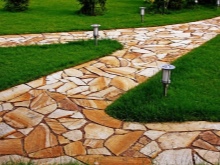
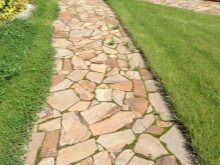
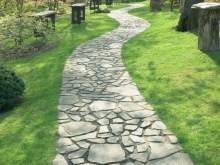
Peculiarities
Dacha paths made of limestone make the adjoining territory of the dacha well-groomed. Tile allows you to create a durable coating. It is a sedimentary rock formed during compaction under the pressure of other types of rock layers. It is mined in open pits by chips from reservoir deposits. The mineral has a tiled structure, its edges can be smooth and chipped. Based on the deposit and the rock, the shade and thickness of the stone may vary.
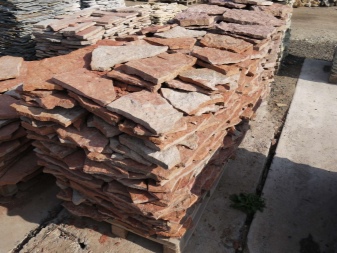

The thickness of the limestone is 2-15 cm. In this case, dense varieties are used for paving. They are able to withstand the weight load on sections of pedestrian zones and access roads. Limestone paths are durable, easy to install and variable in texture. Such paths are combined with any stylistic solution of the garden plot. They fit well into the austere, rustic, creative landscape. Tile is considered a versatile facing material for paving. Its natural decorativeness cannot be compared with any artificial stone.
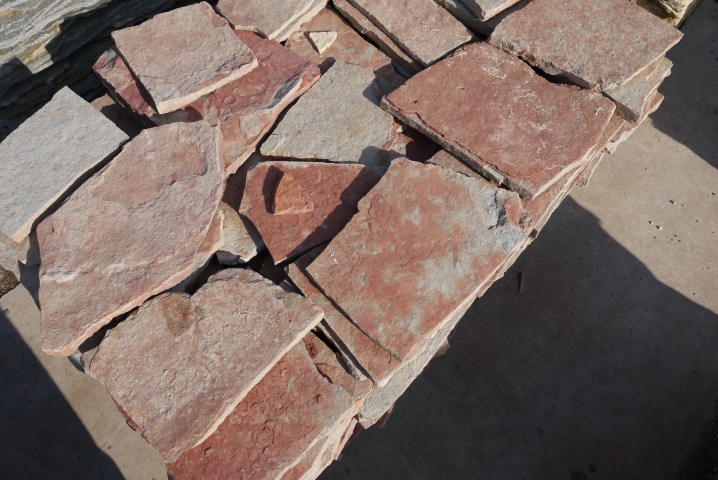
Flat stones undergo minimal processing before finishing. They have a rough, non-slip surface. Such paths are safe for pedestrians both in winter and in bad weather. The colors of the stone are quite persistent, not fading during operation. The slabs are environmentally friendly, durable and frost-resistant. Resistant to moisture and abrasion. It is considered one of the best types of road surface.
The shape of the stones can be oval, chipped, round, rectangular. The stone is inert to atmospheric phenomena and temperature extremes. If necessary, it can be easily cut, grinded, polished. It can be engraved if desired. However, unlike conventional tiles, paving requires a project to be created.
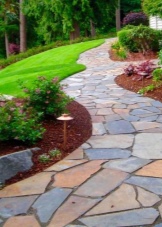
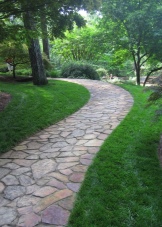
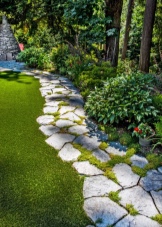
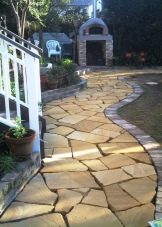
Nuances of design
The design of paving garden paths takes into account the peculiarities of the soil, buildings, landscape. The shape of the limestone path should not have sharp bends. At the same time, it can be both winding and laconic straight.
Design paths so that there are no large trees near them. Their roots can erode paved surfaces over time.
As for other nuances, it is worth paying attention to the key ones.
- The width of the main garden path should be 1.5-3 m.
- The width of the cover for household purposes is 0.7-1.5 m.
- Household paths are always the shortest and straightest.
- Walking, winding and long, but not wide.
- The width of secondary (from other materials) can be 2 times less.
- For the purpose of drainage, the laying of the coating should provide for a slight slope on the sides.
- It is necessary to design an additional drain (grooves).
- Sharp tortuosity and breakage of the tracks are excluded.
- The total paving area should occupy no more than 15% of the total area.
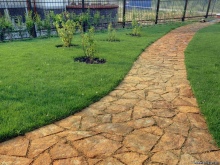
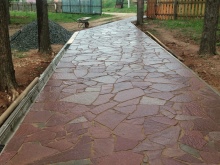
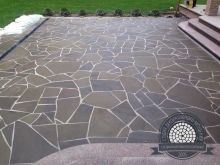
Choosing a limestone
The composition of limestone varies, which is determined by the type of sedimentary rock.
Several types of stone are used for paving garden paths: sand, granite, slate.
Less often, the paths in the country are equipped with limestone or dolomite. Each type of facing material has its own characteristics.For example, sandstone flagstone is affordable and thin. It can be grayish green, yellowish, red, dark gray. Its significant disadvantage is its fragility.
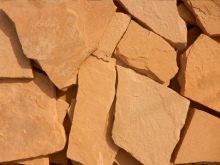
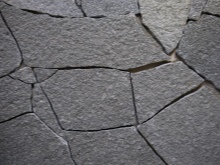
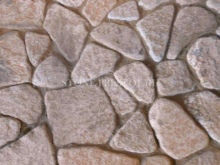
Granite flagstone is the most reliable and durable. With proper installation, such a coating will last over 100 years. The average thickness of the granite stone is 8 cm. To choose a flagstone for paving garden paths, it is necessary to take into account the type of soil and the volume of loads. It is undesirable to buy a large stone: the larger the size, the lower the strength.
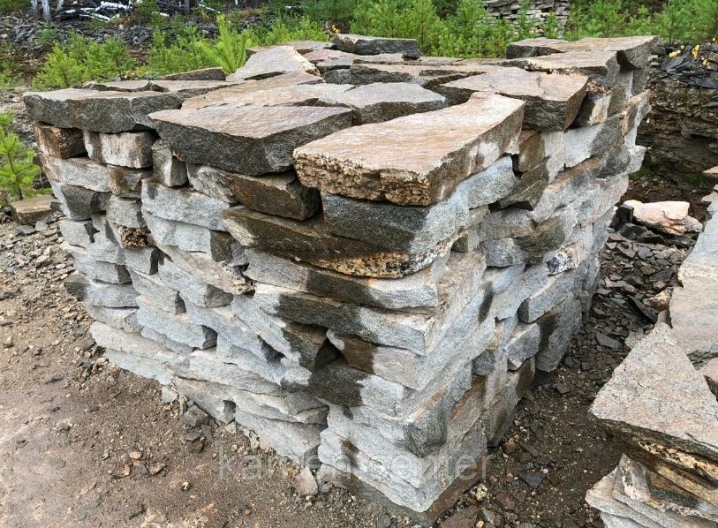
Material parameters should be matched to length and width with minimal trimming. The optimal size of the stone is 10-20 cm on either side. As for the texture, it may vary:
- the tumbling stone is distinguished by the effect of antiquity;
- sandblasted - evenly rough;
- chipped repeats the natural chips of the mineral;
- bush hammered implies a chiseled stone chip;
- sawn provides cutting without surface treatment;
- polished has a relative roughness.
When choosing a material, it is better to take the stone that has no defects. The key ones are flaking, rust and efflorescence.
Delamination of the cladding is fraught with delamination a couple of years after paving. The presence of rust and efflorescence will complicate the lining of the walkways. You will have to spend time cleaning and washing the stone slabs. To get rid of deposits of soluble salts (efflorescence) will have to be done with a brush. In addition, the stone will still have to be covered with a water repellent.

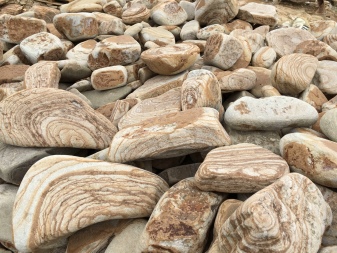
It is better to buy the flagstone, the deposit of which is located in the 1st climatic zone. It will correspond to the peculiarities of the climate of a particular region. The moisture coefficient is important. The longer the limestone is stored in the sun, the lower its strength. The edges of the stone are not so important (they can be easily corrected with a grinder). However, the thickness and dimensions may vary from batch to batch.
Therefore, you need to take material from one batch. Moreover, it should not be damp, otherwise it will begin to crumble immediately after finishing. As for color, green flagstone is stronger and more durable than other types. The softest is a yellowish stone. Mineral of bright color is more susceptible to delamination than others. It has more layers, so it crumbles earlier than other varieties.
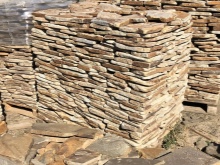
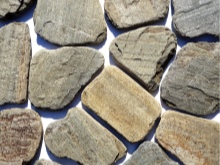

Arrangement options
The arrangement of garden paths at a summer cottage can be different. They can lay out paths with lawn grass between the plates. It can be laid using a suture and seamless technology. In the first case, the stone is selected with gaps of up to 1 cm. When laying seamlessly, the slabs are fitted close to each other. Mismatched parts are trimmed with a grinder.
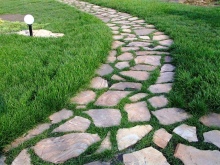
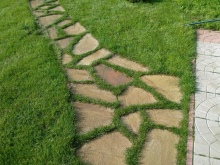
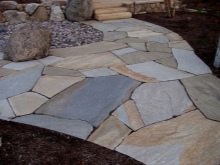
This pattern looks natural and beautiful. However, installation of a seamless type takes more time and effort. More material is spent on it due to trimming and better joining. Laying of limestone can be one-color and contrasting. Spectacular colored paths add a special flavor to the landscape. In this case, the main color can overlap with the facade of the house.
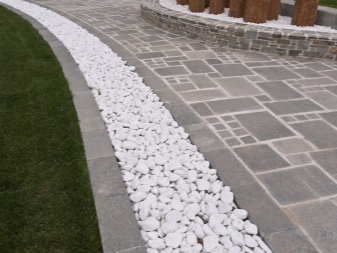

Step-by-step instruction
Do-it-yourself limestone laying technology consists of a number of sequential steps. Despite the different installation method, the preparation of the base is an obligatory step. Initially, it is necessary to calculate the amount of material for paving, focusing on the area of the future site. The calculation is performed by multiplying the width of the path by the length.
This is done for each section of the path, if it has bends. After calculating the areas, they are summed up.
In order not to face the problem of a shortage of raw materials due to fitting in the future, you need to buy flagstone with a margin of 10-15% of the required amount.
When the material is purchased, prepare the tools. The work will come in handy:
- pegs, tape measure, marking rope;
- building level, usually a tape measure;
- shovel, rake, vibrating plate;
- rubber mallet, hammer;
- grinder, concrete mixer, spatula.
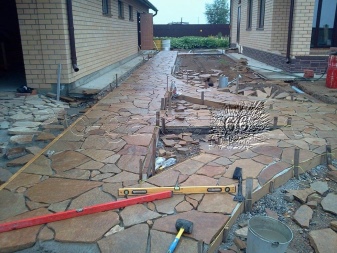
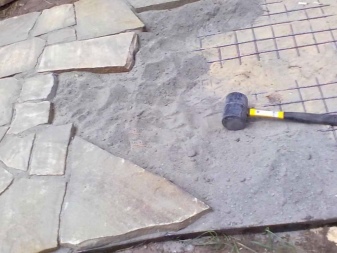
To make the coating correctly, it is necessary to prepare sand, cement, crushed stone, as well as curb slabs. Further preparatory work will require the creation of an approximate layout and the implementation of the base with the laying of the pillow. First of all, markup is performed taking into account the previously selected project.
They take a tape measure, measure the width of the track, plus the dimensions of the side borders to it. The width of the path is checked every half a meter (especially on radial sections). At the boundaries of the base, stakes are driven into the ground, then a rope is pulled over them, marking the boundaries of the future path.
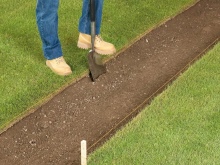
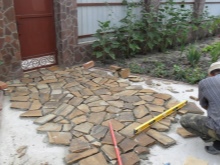
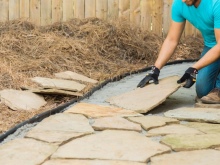
Excavation of the earth is carried out to a depth of 35-50 cm (the parameter depends on the number of layers and the type of cushion under the flagstone). The fertile soil layer is transferred to another place. The bottom of the pit is leveled, and then tamped. Then a layer of crushed stone (10 cm) is poured, since clean sand will not give a uniform load.
Observe a drainage slope of 3 degrees. After leveling the crushed stone layer, a layer of sand (5 cm) is poured on top. A nonwoven material or geotextile is placed on the surface of the drainage layer. It will prevent weeds from germinating. Then a layer of cushion under the flagstone can be placed on the geotextile.

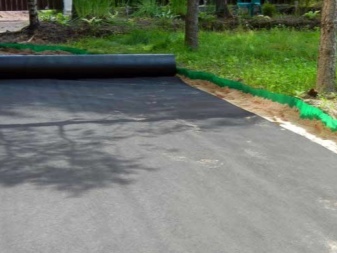
The curb elements on the sides of the path are fixed with cement mortar. The pillow is poured in compliance with the slope. The stone is laid starting with large elements. It is leveled with a rubber mallet. After laying out large stones, the gaps are filled with small fragments. If necessary, the stone must be chipped or cut.
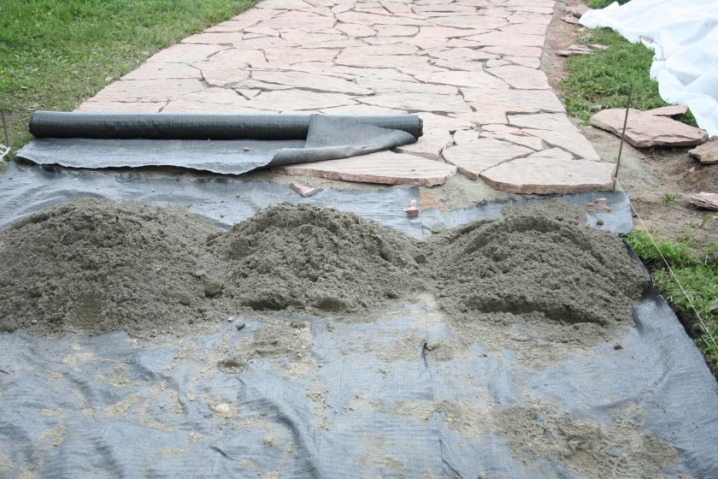
Laying methods
Depending on the type of weight load, the paving base may vary. The slabs are laid on sand, sand and gravel bed, concrete, dry mix or ready-made mortar. Each type of pillow implies its own installation technology.
On the sand
This styling method is simpler than others. It is not particularly practical and is only suitable for paving small and short paths. The scheme of work is as follows:
- a sand cushion is poured over the geotextile (with a layer of 15 cm);
- mount a curb (to prevent the slabs from shifting);
- laying flagstone with seams of 1-2 cm (each element is sunk into the sand);
- the seams between the slabs are covered with sand or lawn grass.
This paving method is not suitable for heaving clay soils. You can lay the stone directly on the sand, bypassing the creation of a drainage layer. However, this technology does not differ in the practicality of the finished coating.
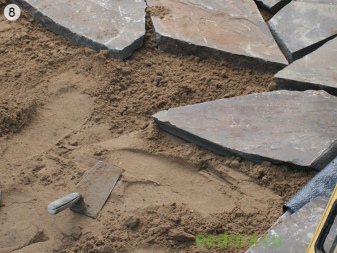
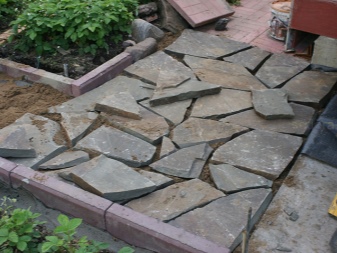
Using a sand and gravel cushion
This technology practically does not differ from paving on a sand cushion. The only difference is one more layer of rubble on top of the geotextile. After it has been leveled and tamped, the limestone is laid. Suture processing is similar to the previous technique.
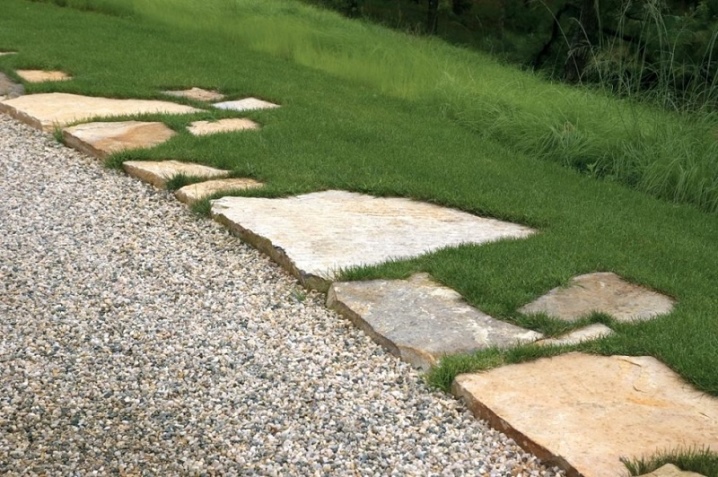
On concrete
Laying the limestone on a gravel-sand pillow is easy in stages. The installation of limestone on concrete involves the installation of formwork under the screed. For work, you can use a stone of medium thickness (3-5 cm). The depth of the flagstone trench in this case is 20-30 cm. The paving technology is as follows:
- after tamping the trench, formwork is mounted on the sides under the screed;
- a rubble layer, crushed stone or broken brick is poured;
- a layer of concrete is poured on top, it is leveled with the rule, left to dry;
- for several days they make sure that the layer does not dry out, for which they moisten the concrete;
- flagstone get rid of dirt and perform an approximate layout;
- all non-abutting edges of the slabs must be trimmed;
- glue is applied to the base and the plates themselves;
- each stone is pressed into the base, removing excess glue;
- at the end of the installation, the surface is cleaned of debris and washed with water.
If the laying is performed on a dry mixture, after laying the stone, the surface is poured abundantly with water. You can seal the joints with a slurry of cement and sand.
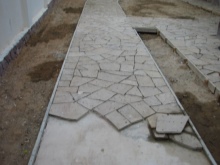
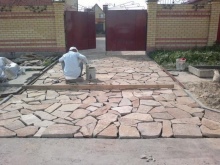
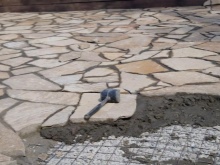
Track maintenance
After installation, the surface can be brushed with metal bristles. For a large amount of work, a drill with a similar attachment is used to cleanse dirt.This will give the stone depth and make it stand out from the lawn. To increase the service life of the coating, it is necessary to treat the stone with an impregnation with moisture and dust-repellent properties. If dirt accumulates on the surface, the track can be rinsed with water from a hose. Fallen leaves also need to be removed, as well as weeds.
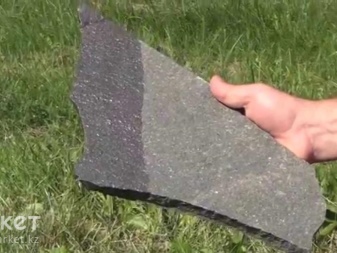
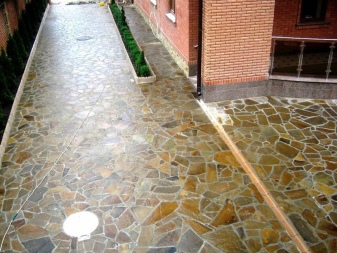
Beautiful examples
We offer several examples of the spectacular design of garden paths with flagstone.
- A winding garden path with brick borders.
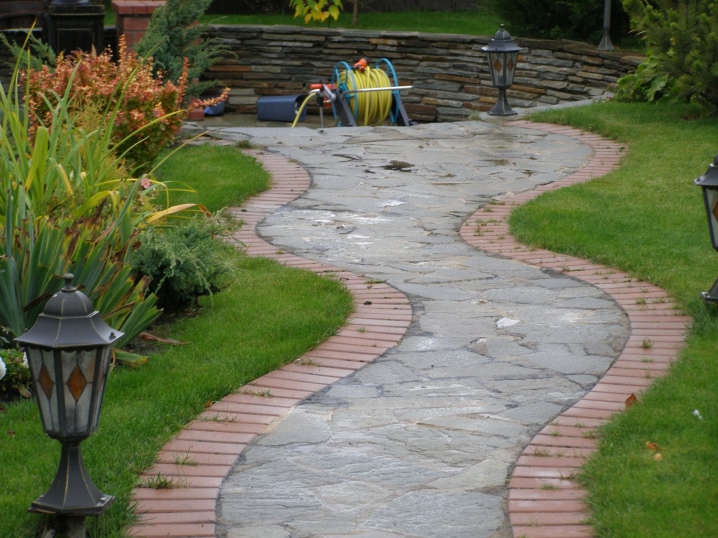
- Paving large slabs bounded by a narrow curb.
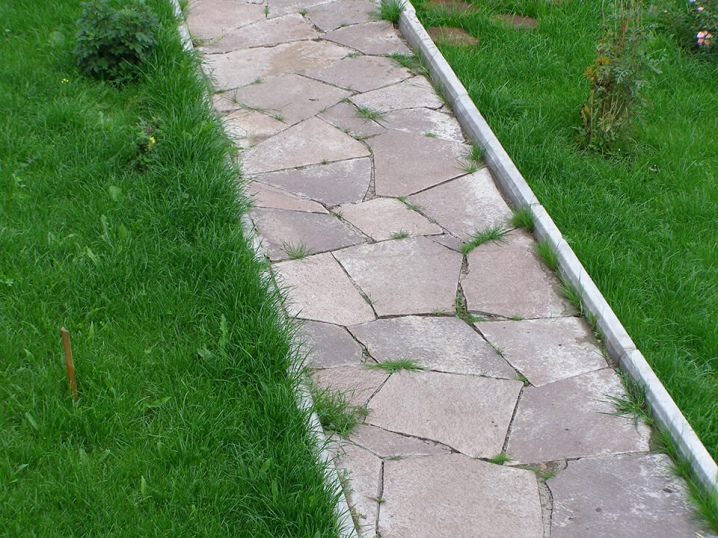
- Straight garden path protruding above the ground.

- A winding path without a border, made using suture technology.
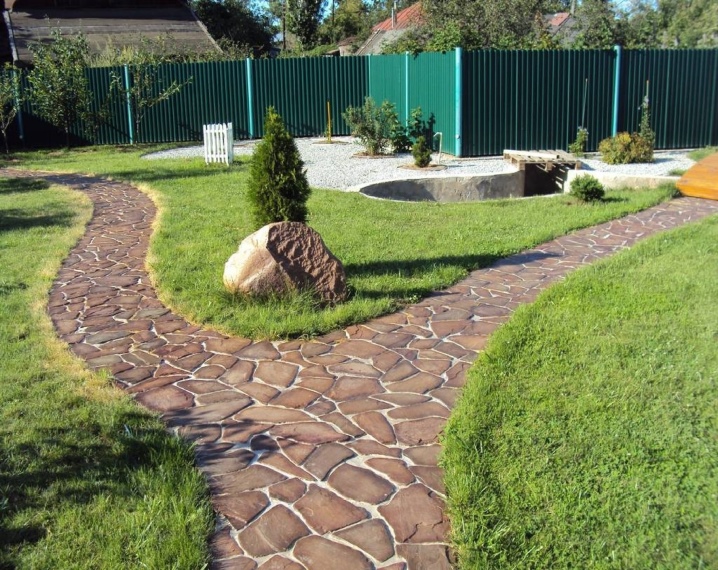
- An example of a walkway with a combination of limestone and other stones.
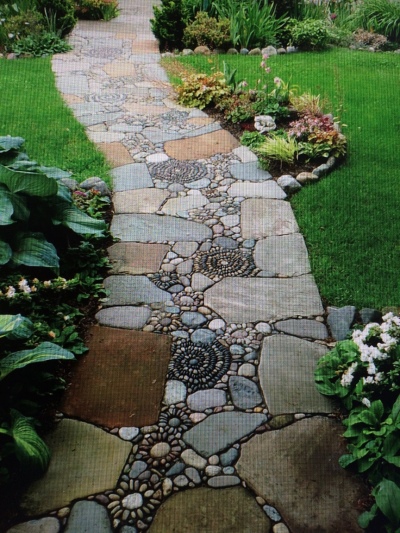
- A wide walkway using square-shaped limestone as a curb.
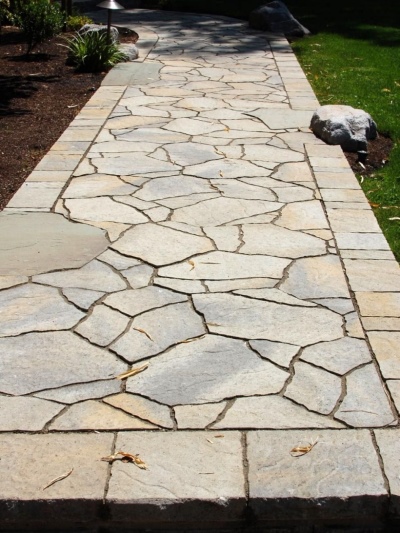
- Tile with grass seams.
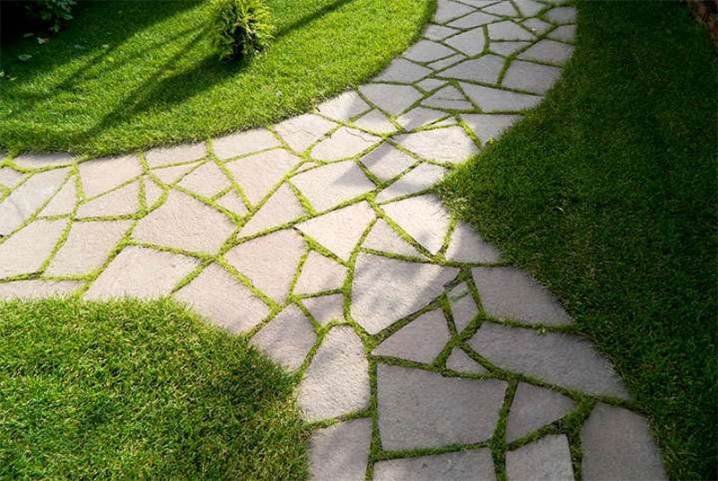
How to make a garden path from limestone on a sand base, see the video.













The comment was sent successfully.